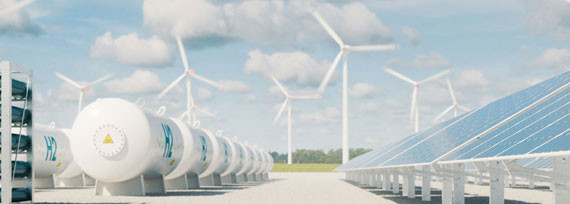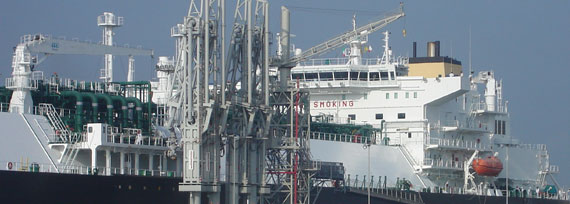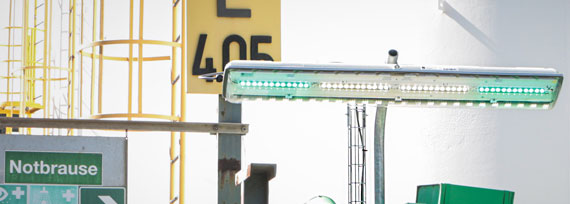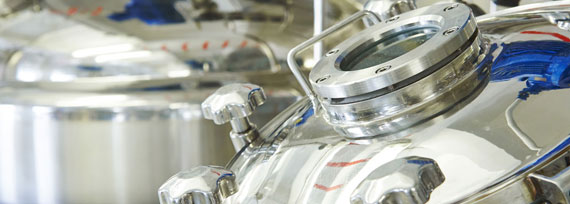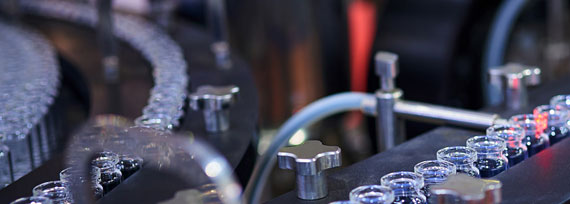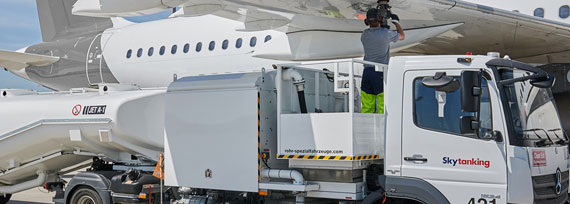Explosion protection with pressurised enclosure type of protection
With the help of the pressurised enclosure, explosion protection is simple and flexible. Above all, it can be used to implement difficult Ex challenges, which is why many users make use of this solution. Two industrial plants in the petrochemical industry in Kuwait and Egypt show how this works in practice.
Three steps for protection
In addition to a high level of safety, Ex p solutions are appreciated primarily for their flexibility and ease of use. The monitoring systems in the pressurised enclosure type of protection consist of an Ex p control unit, Ex p pressure monitors and Ex p purge valves with digital and proportional control. A wide variety of cabinet sizes are available. Furthermore, the purge times and purge pressures can be adapted to suit the requirements at hand. Typical Ex p pressurized enclosures are operated in three separate steps:
Preparation phase: Compressed air or inert gases are transported into the Ex p enclosure via the purge valve and an overpressure is generated. Once this is achieved, the "pre-purging" phase begins; this is regulated via the Ex p control unit.
Pre-purging phase: Before starting up the equipment located inside the cabinet, any explosive mixture that may be present must be blown out of the enclosure. The purge valve opens once the preset internal enclosure pressure has been reached. Next, thorough purging is performed using ignition protection gas. These air outlet valves (pressure monitors) are positioned in different locations in order to guarantee controlled flow behaviour. The extremely short purge times at very low pressure loads (up to 15 mbar) are particularly advantageous. This enables the wall thickness of the cabinet walls to be reduced to 1.5 to 2 mm, as a rule. This, in turn, lowers costs. Once the pre-purging phase is complete, the purge valve closes and the purge flow stops. The internal enclosure pressure returns to the preset value and the air outlet valve closes.
Operating phase: Normal operation begins and the control unit monitors and regulates the internal enclosure pressure in order to prevent explosive gases from entering the enclosure. The purge valve automatically compensates for any leakage losses.
The necessary leakage volumes are reduced to a minimum, ensuring very cost-effective continuous operation. Additionally, a temperature monitoring and control system can be integrated inside the enclosure to provide cooling, as the following usage examples in two refineries show. In both applications, one or even two vortex air coolers have been installed.
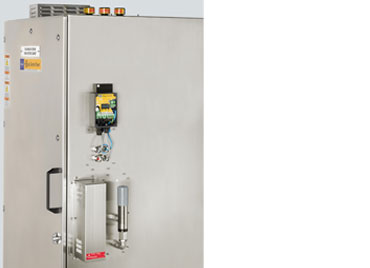
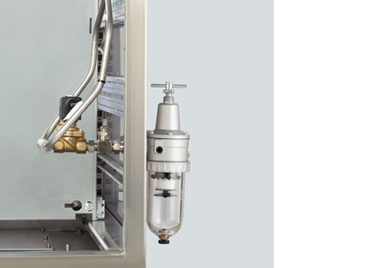
Despite very high ambient temperatures
In a Kuwait refinery, a special measuring instrument monitors the vibrations of a fan. The measured values are consulted to monitor the escaping gas and are therefore important for safe operation of the whole plant. The challenge is that the measuring instrument is only approved for Ex Zone 2 – yet must also function safely in Ex Zone 1. But that was just one reason to choose the Ex p pressurised enclosure degree of protection. The size of the enclosure allows additional components to be housed and is less heavy in comparison to the Ex d solutions. Moreover, the Ex p solution withstands the harsh chemical environment. Perhaps the most important reason – and at the same time the much greater challenge – for the project, however, was the high outside temperature, sometimes up to 55 °C.
Alongside the high outside temperatures, the high power dissipation inside the cabinet also had to be taken into account. There were no real alternatives. It would have been difficult to implement a compressor cooling unit due to the high costs and large amount of space required. In the Kuwait refinery, the decision was made to install a second vortex air cooler in the cabinet to achieve the cooling capability required. However, there were also several challenges to overcome with two vortex air coolers in this solution too. These require 2000 litres of compressed air per minute at 5.5 bar. Even for R. STAHL, this wasn't an everyday job, especially since on-site tests were difficult to implement in advance. That's why an extra test environment was constructed at R. STAHL in Waldenburg, Germany, to perform thorough testing of this solution beforehand.
But that wasn't the only unique aspect. The inside of the cabinet had to look like a Rittal cabinet so that the customer could continue to use the standard components they already had, which for example affected the grid dimensions, the 19" frame, luminaires, etc. However, the Rittal cabinet is not certified for use in the hazardous area. The solution was to design the specially tailor-made cabinet so that it had the required grid dimensions internally, thereby providing the customer with the fastening options they had requested. Then the user could install their usual Rittal accessories, whilst relying on the safety provided by R. STAHL. The advantage of R. STAHL cabinets is that they are fully welded and therefore many times tighter than commercially available cabinets, significantly reducing potential error sources (e.g. leaks) in advance too. This is a requirement for the Ex p type of protection, where there is always a slight overpressure internally.
In detail, the solution comprised a 9850/0 Ex e enclosure with additional struts for Ex p operation. A door was installed at the front and back in the Ex p enclosure to give the customer good access. The displayed was equipped with a folding cover with 6 mm safety glass. The U-certified Ex p enclosure for Zone 1 was completed in IP 66. R. STAHL supplied the Ex p cabinet as a U-certified Ex p empty enclosure. The customer can now fit out the interior of the cabinet and wire it themselves as they would usually. In order to install the cabinet in the hazardous area – as a fully certified 8620/5 Ex p control panel – only a final acceptance is required. The remaining inspections can either be undertaken by an external test body or other experts.
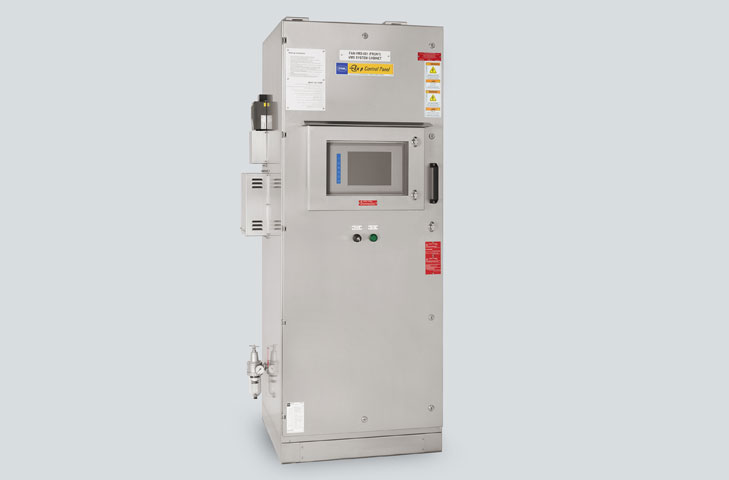
In operation at any time
In an Egyptian refinery, the aforementioned vibration device is not only used for monitoring, but also for control. It was important to the users that this control then also works properly in the event of an electric supply line failure. Therefore, a redundant supply for the Ex p controller is facilitated by an additional connection. Moreover, a bypass key-operated switch is used, with which work can be carried out on and in the cabinet during commissioning or maintenance – despite the door being open and the resultant pressure drop. A precondition for these activities is that there are no explosive gases present. This must be ensured through the process, and generally what is known as a hot work permit is issued to do so. This key-operated switch therefore provides an easy option for bringing the cabinet into bypass operation without special wiring expenditure. After the work is finished, the Ex p monitoring is simply switched back on again without cost-intensive test steps by deactivating the Ex p bypass key-operated switch.
Vortex cooling was needed here too. Yet a single cooling system was sufficient as the climatic requirements, at an ambient temperature of 50 °C, are less extreme than in Kuwait. In addition, the cabinet is located inside a building. As a result, the IP65 degree of protection was sufficient in this case. The double-door Ex p enclosure (which provides Ex e protection at the same time) likewise has additional struts, yet is considerably bigger than its counterpart in Kuwait. There is an additional enclosure in the left-hand door for an Ex i keyboard, with which a SHARK-type HMI can be operated. This is designed for extremely harsh ambient conditions. There is a customer-specific display in a 19" movable frame in the right-hand door. Both components are safely housed behind a foldable panel with 6 mm VSG safety glass.
Although only one vortex cooler was required in Egypt, three Ex p air outlets had to be planned nonetheless, since the cabinet has a large volume. This allows the purge times to be kept short. An R. STAHL LED Ex luminaire was installed on the roof outside with a special bracket. In addition to a control lamp showing whether the solution is operation, a combination of a flashing beacon and horn alerts users in the event of an error (for example, a drop in pressure).
Conclusion
The usage examples show that safe explosion protection with pressurised enclosure degree of protection (Ex p) is possible even at extremely high temperatures. In addition to ease of installation and robustness, what impressed the users in both refineries most of all was the flexibility that even allowed their individual requirements to be safely fulfilled.




